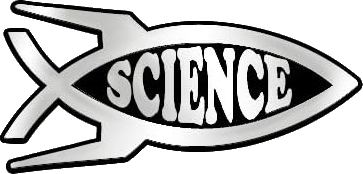Darwin Fish Symbol

The Darwin fish symbol — a parody of the Christian "Ichthys" (Jesus fish) — emerged in the late 1980s to early 1990s, particularly in the United States. During the 1990s–2000s it gained visibility on car bumpers, T-shirts, and as a satirical or critical response to creationist views and a public expression of support for science and secularism.
But that intention not only failed, but had the opposite effect, by encouraging people of opposing beliefs to examine their faith more deeply.
Where the Christian fish symbol is usually shown swimming to the left, the Darwin fish symbol is usually shown swimming in the opposite direction.
Since the 2010s, the symbol can still be seen but feels less culturally prominent. Its role as a countercultural or provocative symbol has faded somewhat as internet memes and newer forms of expression (e.g., social media avatars, science-themed YouTube content) have become more dominant.
Not only has its image become "dated", but its very invention has spawned reflection amongst proponents and opponents of Christianity.
As with the related Science Fish symbol, the Darwin Fish symbol shows the person who displays it is sadly fact-averse about two significant realities:
- Darwin had been a Christian
- Science is embraced by Christians
Darwin had been a Christian
You probably already know that Darwin's theory of evolution by natural selection challenged his belief in traditional Christianity. He became agnostic, famously writing to a correspondent: "I do not believe in the Bible as a divine revelation, and therefore not in Jesus Christ as the Son of God.”
He was born into a Christian family, baptised into the Anglican Church, studied theology at Cambridge University with the intention of becoming a clergyman in the Church of England. He was deeply interested in natural theology, which seeks to understand God through nature. However, he began to observe natural phenomena that raised questions about literal interpretations of the Bible.
He didn't become an atheist; i.e., he didn’t deny the possibility of a creator, rather he became an agnostic. He believed the truth about God was ultimately unknowable.
Darwin had sincere respect for religious people and avoided public religious controversy. In fact, he allowed his wife Emma, a devout Christian, to read his early manuscripts and give feedback — including her concern that it might undermine faith. He remained sensitive to her beliefs throughout their marriage.
So if the Darwin fish symbol is an attempt to mock Christianity, that would be must un-Darwin-like. While it may be intended as satire, the symbol often ends up being more provocative than persuasive. Let’s unpack and critique it.
- It misrepresents Darwin. He wasn't an atheist evangelist trying to destroy Christianity. Using Darwin's name in a mock-religious context mischaracterises the man himself.
- It misunderstands the purpose of the Ichthys symbol; an ancient Christian symbol that predates Darwin by over 1,800 years, a symbol of hope, identity and belief — not science-versus-superstition.
- The Darwin fish isn’t a symbol of science, it’s a symbol of ridicule. It makes evolution look ideological, when in fact science thrives on evidence, logic and humility — not on symbols, dogma or mockery. The Darwin fish turns a scientific theory into a badge of cultural superiority. It makes evolution appear less like a rigorous framework of biology and more like a competing religion.
- If the goal is to promote understanding of evolution or dialogue between science and faith, mocking religious symbols achieves the opposite. It reinforces the false idea that you must choose either science or faith.
- If the goal is to share science, build dialogue, or encourage rational thought, there are far better tools than sarcastic bumper stickers.
Science is embraced by Christians

Despite an attempt to mock Christianity with a Science fish car bumper sticker, science is embraced by most Christians. There's strong evidence to support that most mainstream Christian groups formally accept scientific consensus on key issues, including evolution.
For the Roman Catholic Church, the Vatican officially accepts evolution and Big Bang cosmology. Pope John Paul II called evolution "more than a hypothesis", and Pope Francis affirmed that God is not “a magician with a magic wand”. Anglican Communion, Lutheran, Methodist and Presbyterian Churches also accept evolution, medical science, and climate science.
Surveys show most Christians accept science and medicine. A 2014 Pew Research Center study found that nearly 70% of U.S. Christians see no conflict between their personal religious beliefs and science in general. In a BioLogos Foundation survey (2021), 84% of U.S. Christians said science and faith can coexist.
Most Christians trust doctors and medical science, with high rates of support for vaccinations, public health, and technological advances. Christians widely accept science in everyday life — using GPS, flying in planes, having surgery, using smartphones — without any theological crisis.
Some of the most respected scientists have been, or are, devout Christians. Christian universities and seminaries routinely offer science degrees and produce graduates who go on to careers in research, medicine and engineering. Institutions like Notre Dame, Baylor, and Wheaton College are Christian yet fully accredited in scientific fields. Many Christian schools teach evolution, biology and physics, alongside theology, showing that integration is the norm, not the exception.
Most Christians don't see science as a threat to faith, but as a tool for understanding God’s creation. The loudest anti-science voices tend to be a vocal minority, often linked to cults and specific fundamentalist groups, not the Christian majority.
“Science is thinking God’s thoughts after Him”. A quote attributed to Johannes Kepler, early astronomer and devout Christian.